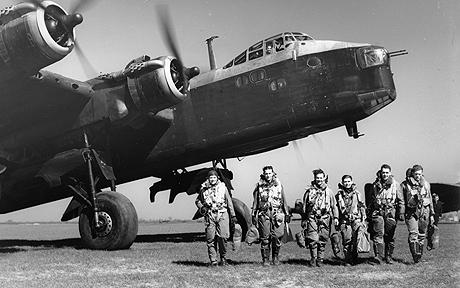The 199 Sqdn left from Lakenheath at 1944-02-16 at 23:05. Loc or duty SOE
He flew with a Short Stirling (type III, serial EF271, code EX-F).
Campaign report of the USAAF:
14 February 1944
General Dwight D Eisenhower establishes HQ Supreme Headquarters Allied Expeditionary Force (SHAEF). Chief of Staff, Supreme Allied Commander (COSSAC) comes under control of SHAEF.
STRATEGIC OPERATIONS
(Eighth Air Force): Mission 222: 48 P-47s are dispatched to Eindhoven Airfield in the Netherlands; the primary target is overcast and 46 of 48 hit Gilze-Rijen Airfield without loss. 22d Photographic Reconnaissance Squadron, 7th Photographic Group (Reconnaissance) based at Mount Farm, England, sends a detachment to operate from Attlebridge, England with F-5s.
15 February 1944
STRATEGIC OPERATIONS
(Eighth Air Force): Mission 223: 52 of 54 B-24s hit V-weapon sites at St Pol/Siracourt, France; 29 B-24s are damaged; no losses or casualties. Mission 224: 95 P-47s are dispatched to bomb 2 airfields in France but are recalled; 1 P-47 is damaged; no casualties Mission 225: 6 of 6 B-17s drop 300 bundles of leaflets on Orleans, Chartres, Cambrai, Le Mans, Lille and Reims, France at 2124-2155 hours without loss.
TACTICAL OPERATIONS
(Ninth Air Force): 194 B-26s bomb V-weapon sites, Cherbourg/Maupertus Airfield and targets of opportunity during a morning mission. 122 B-26s again bomb V-weapon construction sites in the coastal area of N France during the afternoon. HQ IX Air Support Command moves from Middle Wallop to Uxbridge, England. HQ 316th Troop Carrier Group arrives at Cottesmore, England from Sicily.
17 February 1944
TACTICAL OPERATIONS
(Ninth Air Force): Advanced HQ, Ninth Air Force, is opened at Hillingdon House, Uxbridge. It is later joined in the area by advanced units of the IX Fighter Command and by troop carrier units, all of which form a nucleus of advanced echelons so as to centralize tactical operations in anticipation of combat on the Continent. Arrivals in England from Sicily: HQ 52d Troop Carrier Wing at Cottesmore; 15th Troop Carrier Squadron, 61st Troop Carrier Group, at Bardston with C-47s.
18 February 1944
STRATEGIC OPERATIONS
(Eighth Air Force): HQ Eighth Air Force issues orders to establish a photographic reconnaissance wing [8th Reconnaissance Wing (Provisional)] in Cheddington. The purpose is to make the Eighth independent in aerial reconnaissance and to consolidate the efforts of units presently engaged in this and related activities. Colonel Elliott Roosevelt, the President's son and currently Director of Reconnaissance for the Ninth Air Force, is named Commanding Officer.
TACTICAL OPERATIONS
(Ninth Air Force): HQ 61st Troop Carrier Group arrives at Barkston, England from Sicily.
Campaign report of the RAF:
15/16 February 1944
After a rest of more than 2 weeks for the regular bomber squadrons, 891 aircraft - 561 Lancasters, 314 Halifaxes, 16 Mosquitos - were dispatched to Berlin. This was the largest force sent to Berlin and the largest non-1,000 bomber force sent to any target, exceeding the previous record of 826 aircraft (which included Stirlings and Wellingtons) sent to Dortmund on the night of 23/24 May 1943. It was also the first time that more than 500 Lancasters and more than 300 Halifaxes were dispatched. The German controllers were able to plot the bomber stream soon after it left the English coast but the swing north over Denmark for the approach flight proved too far distant for many of the German fighters. The German controller ordered the fighters not to fly over Berlin, leaving the target area free for the flak, but many fighters ignored him and attacked bombers over the city. The diversion to Frankfurt-on-Oder failed to draw any fighters. 43 aircraft - 26 Lancasters, 17 Halifaxes -were lost, 4.8 per cent of the force.
Berlin was covered by cloud for most of the raid. Heavy bombing fell on the centre and south-western districts and some of Berlin's most important war industries were hit, including the large Siemensstadt area. This was really the end of the true 'Battle of Berlin'; only one more raid took place on the city in this period and that was not for more than a month.
23 Oboe Mosquitos attacked 5 night-fighter airfields in Holland, 43 Stirlings and 4 Pathfinder Halifaxes carried out minelaying in Kiel Bay, 24 Lancasters of No 8 Group made a diversion raid on Frankfurt-on-Oder, 9 aircraft made RCM flights and 14 Mosquitos carried out Serrate patrols. A Serrate Mosquito was the only aircraft lost.
2 Mosquitos to Aachen, 6 Stirlings and 6 Wellingtons minelaying off Bayonne and Lorient, 48 aircraft on Resistance operations. 1 Stirling lost from a Resistance flight.
Total effort for the night: 1,070 sorties, 45 aircraft (4.2 per cent) lost.
With thanks to the RAF and USAAF.net!
This record can also be found on the maps of Back to Normandy with Google coordinates. You can find the maps by clicking on this link on this location.
There are several possibilities to investigate the flight records on Back to Normandy. All the flights are plotted on maps, sorted "day by day", "by squadron", "by type aircraft", "by year or month", "by location" and much more! Don't miss this!!!
If you have any information that you want to share, please add your comment at the bottom of this record. Or send your information to [email protected]. This information will be added to the record.
Your photos and your information are very welcome! The young do care and with your help we keep up the good work.



